Neutralisation reaction - Study guides, Class notes & Summaries
Looking for the best study guides, study notes and summaries about Neutralisation reaction? On this page you'll find 71 study documents about Neutralisation reaction.
Page 2 out of 71 results
Sort by
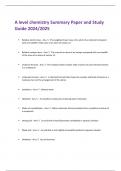
-
A level chemistry Summary Paper and Study Guide 2024/2025
- Exam (elaborations) • 6 pages • 2024
- Available in package deal
-
- $7.99
- + learn more
▪ Relative atomic mass - Ans .The weighted mean mass of an atom of an element compared with one-twelfth of the mass of an atom of carbon-12. ▪ Relative isotopic mass - Ans .The mass of an atom of an isotope compared with one-twelfth of the mass of an atom of carbon-12. ▪ empirical formula - Ans .The simplest whole number ratio of atoms of each element present in a compound ▪ molecular formula - Ans .A chemical formula that shows the number and kinds of atoms in a molecule, but...

-
Chemistry- Acids, Bases, and Buffers questions and answers graded A+
- Exam (elaborations) • 9 pages • 2023
-
Available in package deal
-
- $14.99
- + learn more
Chemistry- Acids, Bases, and Buffers Define Acid - correct answer A proton donor. Define Base - correct answer A proton acceptor. Why is H+ a Proton - correct answer Because hydrogen is just one proton and one electron. Take away the electron and you're left with H+. Define Alkali - correct answer A type of base which dissolves in water to form OH- ions (a soluble base). What is a Monobasic Acid and Give an Example of One - correct answer A monobasic acid e.g. HCl is an acid which ...
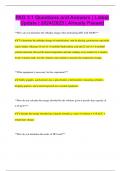
-
PAG 3.1 Questions and Answers | Latest Update | 2024/2025 | Already Passed
- Exam (elaborations) • 3 pages • 2024
-
Available in package deal
-
- $8.94
- + learn more
PAG 3.1 Questions and Answers | Latest Update | 2024/2025 | Already Passed **How can you determine the enthalpy change when neutralising HCl with NaOH?** To determine the enthalpy change of neutralisation, start by placing a polystyrene cup inside a glass beaker. Measure 25 cm3 of 1.0 mol/dm3 hydrochloric acid and 25 cm3 of 1.0 mol/dm3 sodium hydroxide. Record the initial temperature and take readings every minute for 4 minutes. At the 4-minute mark, mix the solutions and continue to me...
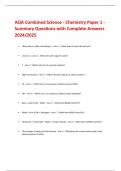
-
AQA Combined Science - Chemistry Paper 1 - Summary Questions with Complete Answers 2024/2025
- Exam (elaborations) • 5 pages • 2024
- Available in package deal
-
- $5.49
- + learn more
▪ How acidic or alkali something is. - Ans .What does the pH scale tell you? ▪ one to six - Ans .What's the pH range for acids? ▪ 7 - Ans .What's the pH of a neutral solution? ▪ Eight to Fourteen - Ans .What's the pH range of an alkali solution? ▪ H+ - Ans .Which ion in an aqueous solution causes acidity? ▪ OH- - Ans .Which ion in an aqueous solution causes alkalinity? ▪ Base + Acid à Salt + Water - Ans .What does BASW stand for? ▪ Metal + Acid à Salt + Hydrogen - Ans...
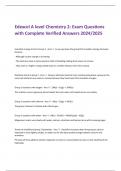
-
Edexcel A level Chemistry 2: Exam Questions with Complete Verified Answers 2024/2025
- Exam (elaborations) • 31 pages • 2024
- Available in package deal
-
- $12.49
- + learn more
Ionisation energy trend in Group 2 - Ans .As you go down the group first ionisation energy decreases because: - Although nuclear charge is increasing - The electrons have an extra quantum shell of shielding making them easier to remove - They exist in a higher energy orbital (and/ or a further distance from the nucleus) Reactivity trend in group 2 - Ans .Group 2 elements become more reactive going down a group as the outer two electrons are easier to remove because they have lower first ...
![AQA GCSE COMBINED SCIENCE: SYNERGY 8465/3F Foundation Tier Paper 3 Physical Sciences Version: 1.0 Final G/LM/Jun23/E6 8465/3F (JUN2384653F01) GCSE COMBINED SCIENCE: SYNERGY Foundation Tier Paper 3 Physical SciencesQUESTION PAPER & MARKING SCHEME/ [MERGED]](/docpics/4429111/65c12af275ed6_4429111_121_171.jpeg)
-
AQA GCSE COMBINED SCIENCE: SYNERGY 8465/3F Foundation Tier Paper 3 Physical Sciences Version: 1.0 Final G/LM/Jun23/E6 8465/3F (JUN2384653F01) GCSE COMBINED SCIENCE: SYNERGY Foundation Tier Paper 3 Physical SciencesQUESTION PAPER & MARKING SCHEME/ [MERGED]
- Exam (elaborations) • 74 pages • 2024
- Available in package deal
-
- $9.99
- + learn more
GCSE COMBINED SCIENCE: SYNERGY 8465/3F Foundation Tier Paper 3 Physical Sciences Version: 1.0 Final G/LM/Jun23/E6 8465/3F (JUN2384653F01) GCSE COMBINED SCIENCE: SYNERGY Foundation Tier Paper 3 Physical Sciences Friday 9 June 2023 Afternoon Time allowed: 1 hour 45 minutes Materials For this paper you must have: l a ruler l a protractor l a scientific calculator l the periodic table (enclosed) l the Physics Equations Sheet (enclosed). Instructions l Use black ink or black ball-po...
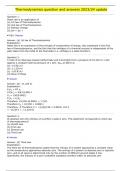
-
Thermodynamics question and answers 2023/24 update
- Exam (elaborations) • 7 pages • 2023
-
- $15.99
- + learn more
Thermodynamics question and answers 2023/24 update Question 1. Hesss law is an application of (a) 1st law of Thermodynamics (b) 2nd law of Thermodynamics (c) Entropy change (d) ∆H = ∆U + P∆V. Question 2. 5 mole of an ideal gas expand isothermally and irreversibly from a pressure of 10 atm to 1 atm against a constant external pressure of 1 atm. Wirr at 300 K is: (a) -15.921 kJ (b) -11.224 kJ (c) -110.83 kJ (d) None of these Question 3. At absolute zero the entropy of a perf...
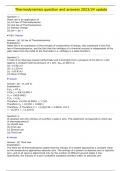
-
Thermodynamics question and answers 2023/24 update
- Exam (elaborations) • 7 pages • 2023
-
- $15.99
- + learn more
Thermodynamics question and answers 2023/24 update Question 1. Hesss law is an application of (a) 1st law of Thermodynamics (b) 2nd law of Thermodynamics (c) Entropy change (d) ∆H = ∆U + P∆V. Question 2. 5 mole of an ideal gas expand isothermally and irreversibly from a pressure of 10 atm to 1 atm against a constant external pressure of 1 atm. Wirr at 300 K is: (a) -15.921 kJ (b) -11.224 kJ (c) -110.83 kJ (d) None of these Question 3. At absolute zero the entropy of a perf...
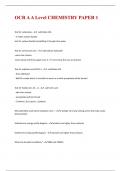
-
OCR A A Level CHEMISTRY | Questions and Answers with complete solution
- Exam (elaborations) • 4 pages • 2023
- Available in package deal
-
- $4.49
- + learn more
Test for carbonates - - add dilute HCL - it makes carbon dioxide test for carbon dioxide by bubbling it through lime water Test for ammonium ions - -add sodium hydroxide -warm the mixture -hover damp red litmus paper over it , if it turns blue the ions are present Test for sulphate ionz (SO4 2-) - - add dilute HCL - then add BaCl2 - BaSO4 is made which is insoluble in water so a white precipitate will be formed Test for Halides (Cl-, Br-, I-) - - add nitric acid - add silver nitrate -...
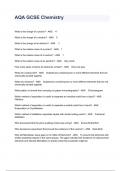
-
AQA GCSE Chemistry
- Exam (elaborations) • 19 pages • 2023
-
Available in package deal
-
- $11.49
- + learn more
AQA GCSE Chemistry What is the charge of a proton? - ANS +1 What is the charge of a neutron? - ANS 0 What is the charge of an electron? - ANS -1 What is the relative mass of a proton? - ANS 1 What is the relative mass of a neutron? - ANS 1 What is the relative mass of an electron? - ANS Very small How many types of atoms do elements contain? - ANS Only one type What are compounds? - ANS Substances containing two or more different elements that...

Do you wonder why so many students wear nice clothes, have money to spare and enjoy tons of free time? Well, they sell on Stuvia! Imagine your study notes being downloaded a dozen times for $15 each. Every. Single. Day. Discover all about earning on Stuvia


